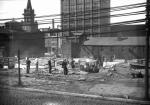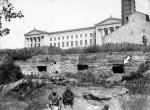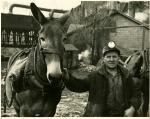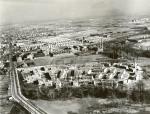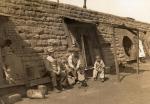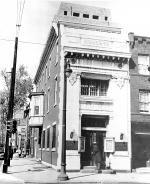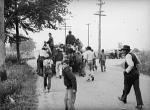Chapter 1: The Great Depression Strikes Pennsylvania
The impact of the Great Depression in Pennsylvania was as complex and as varied as the state itself. This was particularly true during the early 1930s, before wide-scale federal relief helped reduce unemployment and some of the worst suffering. The broad diversity of communities and institutions in the state also resulted in a broad diversity of reactions and responses to the crisis.
Pennsylvania's single industry towns felt the Depression particularly hard. Unemployment in both anthracite and bituminous coal mining communities ran perilously high, a circumstance aggravated by the fact that the coal industry had already slumped by the 1920s.
With mines closed or abandoned, coal miners became one of the most vulnerable occupational groups in the country during the early years of the Depression. (New Deal relief programs would later specifically target "stranded miners.") Bitter strikes and violence also flared, especially in the bituminous coal fields of southwestern Pennsylvania, one of the regions struck hardest by the Great Depression. In 1933,
struck hardest by the Great Depression. In 1933, Governor Gifford Pinchot sent the National Guard of Pennsylvania to help maintain the peace during a futile strike of more than 70,000 that left even more miners idled and
Governor Gifford Pinchot sent the National Guard of Pennsylvania to help maintain the peace during a futile strike of more than 70,000 that left even more miners idled and  economically distressed.
economically distressed.
Physically isolated and dependent on the mines for their livelihoods, many miners in Schuylkill County and throughout the northeastern anthracite coal region turned to illegal bootleg mining, digging out coal from mines that operators had either abandoned or shuttered. Bootleg mining became so lucrative and widespread that the Commonwealth estimated it was losing millions in uncollected tax revenues. Many local businessmen and civic leaders, however, supported it wholeheartedly, for its revenues were all that kept their towns and their businesses going.
Schuylkill County and throughout the northeastern anthracite coal region turned to illegal bootleg mining, digging out coal from mines that operators had either abandoned or shuttered. Bootleg mining became so lucrative and widespread that the Commonwealth estimated it was losing millions in uncollected tax revenues. Many local businessmen and civic leaders, however, supported it wholeheartedly, for its revenues were all that kept their towns and their businesses going.
Like the coal patches, most Pennsylvania steel towns also were anchored to a single large employer. Employing thousands at a broad range of skill levels, steel plants were frequently the only employer in town, a fact that made workers and their families nearly as vulnerable to the downturn as coal miners.
Duquesne, home to Duquesne Steel, and others steel making communities in the once productive Mon Valley near Pittsburgh soon faced crippling levels of unemployment. In Braddock, where U.S. Steel shut down entirely for a time, thousands were without jobs. Even though U.S. Steel had deep pockets, it could no longer fund the libraries, hospitals, athletic leagues, and "welfare capitalism" programs it had established in the 1910s and 1920s.
Duquesne Steel, and others steel making communities in the once productive Mon Valley near Pittsburgh soon faced crippling levels of unemployment. In Braddock, where U.S. Steel shut down entirely for a time, thousands were without jobs. Even though U.S. Steel had deep pockets, it could no longer fund the libraries, hospitals, athletic leagues, and "welfare capitalism" programs it had established in the 1910s and 1920s.
Many of Pennsylvania's mid-sized cities were single industry towns to varying degrees - Johnstown and steel, Altoona and railroads, Reading and textiles - and thus shared a similar fate. The handful of Pennsylvania cities with a more diversified manufacturing base found themselves in a better position.
Mid-sized cities with diversified economies, including Harrisburg and Allentown and to a lesser extent, Lancaster, and York, had a greater distribution of political and financial leadership that allowed them to consider a wide range of strategies to weather the storm. But even in these towns, the Depression triggered deep changes in employment and families. By 1933, more than half Pennsylvania's sixteen and seventeen-year-olds had left school and taken low-paying jobs, precipitating a renewed
Allentown and to a lesser extent, Lancaster, and York, had a greater distribution of political and financial leadership that allowed them to consider a wide range of strategies to weather the storm. But even in these towns, the Depression triggered deep changes in employment and families. By 1933, more than half Pennsylvania's sixteen and seventeen-year-olds had left school and taken low-paying jobs, precipitating a renewed  child labor crisis in the Commonwealth.
child labor crisis in the Commonwealth.
As the largest city in Pennsylvania, Philadelphia enjoyed the most diverse economy in the Commonwealth. Thanks to its banking, shipping, textiles, and other enterprises, Philadelphia supported a diverse skilled and unskilled, white- and blue-collar workforce. But the city's sheer size and complexity created its own set of burdens. And Philadelphia's response to the crisis was hampered by leaders strongly opposed to government-supplied relief. The Committee on Unemployment Relief, formed by local philanthropists in 1931, struggled to provide private relief for city residents through traditional methods that were quickly overwhelmed by the scale of the crisis.
Philadelphia enjoyed the most diverse economy in the Commonwealth. Thanks to its banking, shipping, textiles, and other enterprises, Philadelphia supported a diverse skilled and unskilled, white- and blue-collar workforce. But the city's sheer size and complexity created its own set of burdens. And Philadelphia's response to the crisis was hampered by leaders strongly opposed to government-supplied relief. The Committee on Unemployment Relief, formed by local philanthropists in 1931, struggled to provide private relief for city residents through traditional methods that were quickly overwhelmed by the scale of the crisis.
After 1932, Philadelphia suffered through year after year of bitter, violent, and at times deadly strikes, marches, lock-outs, bombings, riots, and mass demonstrations. Convinced that the best way to help his city was to raise its bond ratings and support business-and fearful of the support these jobs would give to the city's Democratic Party-Republican Mayor J. Hampton Moore refused federal assistance, long after the WPA and other work relief programs elsewhere in the state were putting the unemployed back to work on construction projects of great benefit to their communities.
The Depression also wreaked havoc with local institutions across Pennsylvania. The crash produced a dramatic loss in public confidence and triggered a run on deposits that threatened to drain the resources of many of the state's banks. Citizens and Southern, a small African-American savings and loan in Philadelphia, was one of the few success stories.
Citizens and Southern, a small African-American savings and loan in Philadelphia, was one of the few success stories.
Many other businesses that relied on consumer spending, including John Wanamaker's fabled Philadelphia department store, also struggled. The Depression forced many downtown retailers to change the way they did business, and to rethink the best way to reach customers with diminished discretionary income.
John Wanamaker's fabled Philadelphia department store, also struggled. The Depression forced many downtown retailers to change the way they did business, and to rethink the best way to reach customers with diminished discretionary income.
During the 1930s, Pennsylvanians living on farms and in small rural communities-close to one-third the state's population-were probably insulated most from the effects of the Depression. In 1933, prices for cereal crops were half what they had been the year before, the cost of raising potatoes was greater than their market value, and dairymen were receiving the lowest prices they had received since 1879. Yet the familiar images that dominated the urban version of the 1930s-Hoovervilles, breadlines, rallies, and protest marches-never materialized in rural Pennsylvania.
Accustomed to living off the land, farming families were in a much better position to provide for themselves than were those dependent on large employers. Used to living close to the edge and surrounded by poverty, they also were more reluctant to support or take public relief. And once federal agricultural programs were available, most Pennsylvania farmers proved slow to participate in them.
But the Depression did reveal the limits of rural communities' economic independence, for most were connected to the market economy and dependent on urban consumers. The provision of relief could also be contentious in rural counties, where many residents preferred locally administered aid to county or state relief boards, which they believed ignored sparsely settled sections of the county in favor of areas with industry.
On the eve of the Great Depression, relief for Pennsylvania's poor was provided by private philanthropists, local charities, the political operatives in control of local governments, and an archaic and politically controlled system of public charity run by county poor boards. The onset of the Great Depression quickly pushed this system beyond its breaking point.
At first, churches and synagogues, businesses, and private charities like the Salvation Army did their best to meet the crisis. But private charity and state and local relief efforts were quickly overwhelmed by the sheer scale of the crisis. At no other time in American or Pennsylvania history had so many people been in such great need. That need would precipitate the largest government relief program in the nation's history and the other sweeping reforms of the Franklin Delano Roosevelt's New Deal.
Salvation Army did their best to meet the crisis. But private charity and state and local relief efforts were quickly overwhelmed by the sheer scale of the crisis. At no other time in American or Pennsylvania history had so many people been in such great need. That need would precipitate the largest government relief program in the nation's history and the other sweeping reforms of the Franklin Delano Roosevelt's New Deal.
Pennsylvania's single industry towns felt the Depression particularly hard. Unemployment in both anthracite and bituminous coal mining communities ran perilously high, a circumstance aggravated by the fact that the coal industry had already slumped by the 1920s.
With mines closed or abandoned, coal miners became one of the most vulnerable occupational groups in the country during the early years of the Depression. (New Deal relief programs would later specifically target "stranded miners.") Bitter strikes and violence also flared, especially in the bituminous coal fields of southwestern Pennsylvania, one of the regions
Physically isolated and dependent on the mines for their livelihoods, many miners in
Like the coal patches, most Pennsylvania steel towns also were anchored to a single large employer. Employing thousands at a broad range of skill levels, steel plants were frequently the only employer in town, a fact that made workers and their families nearly as vulnerable to the downturn as coal miners.
Duquesne, home to
Many of Pennsylvania's mid-sized cities were single industry towns to varying degrees - Johnstown and steel, Altoona and railroads, Reading and textiles - and thus shared a similar fate. The handful of Pennsylvania cities with a more diversified manufacturing base found themselves in a better position.
Mid-sized cities with diversified economies, including Harrisburg and
As the largest city in Pennsylvania,
After 1932, Philadelphia suffered through year after year of bitter, violent, and at times deadly strikes, marches, lock-outs, bombings, riots, and mass demonstrations. Convinced that the best way to help his city was to raise its bond ratings and support business-and fearful of the support these jobs would give to the city's Democratic Party-Republican Mayor J. Hampton Moore refused federal assistance, long after the WPA and other work relief programs elsewhere in the state were putting the unemployed back to work on construction projects of great benefit to their communities.
The Depression also wreaked havoc with local institutions across Pennsylvania. The crash produced a dramatic loss in public confidence and triggered a run on deposits that threatened to drain the resources of many of the state's banks.
Many other businesses that relied on consumer spending, including
During the 1930s, Pennsylvanians living on farms and in small rural communities-close to one-third the state's population-were probably insulated most from the effects of the Depression. In 1933, prices for cereal crops were half what they had been the year before, the cost of raising potatoes was greater than their market value, and dairymen were receiving the lowest prices they had received since 1879. Yet the familiar images that dominated the urban version of the 1930s-Hoovervilles, breadlines, rallies, and protest marches-never materialized in rural Pennsylvania.
Accustomed to living off the land, farming families were in a much better position to provide for themselves than were those dependent on large employers. Used to living close to the edge and surrounded by poverty, they also were more reluctant to support or take public relief. And once federal agricultural programs were available, most Pennsylvania farmers proved slow to participate in them.
But the Depression did reveal the limits of rural communities' economic independence, for most were connected to the market economy and dependent on urban consumers. The provision of relief could also be contentious in rural counties, where many residents preferred locally administered aid to county or state relief boards, which they believed ignored sparsely settled sections of the county in favor of areas with industry.
On the eve of the Great Depression, relief for Pennsylvania's poor was provided by private philanthropists, local charities, the political operatives in control of local governments, and an archaic and politically controlled system of public charity run by county poor boards. The onset of the Great Depression quickly pushed this system beyond its breaking point.
At first, churches and synagogues, businesses, and private charities like the







